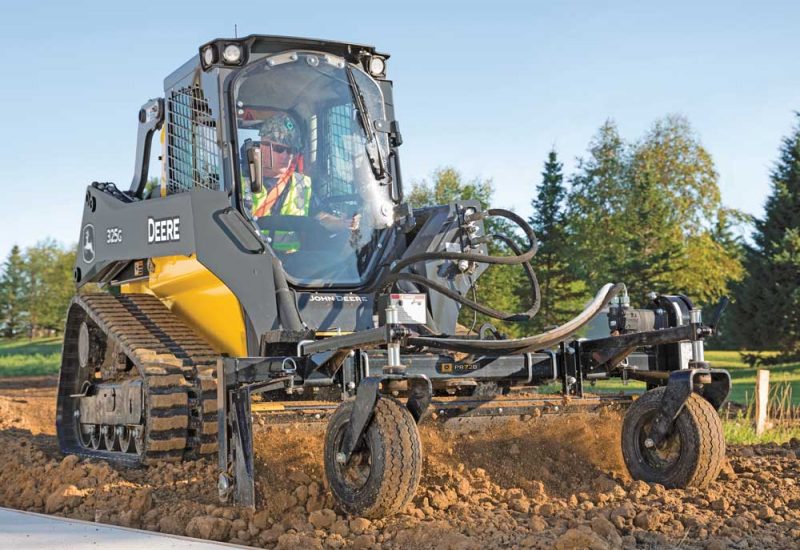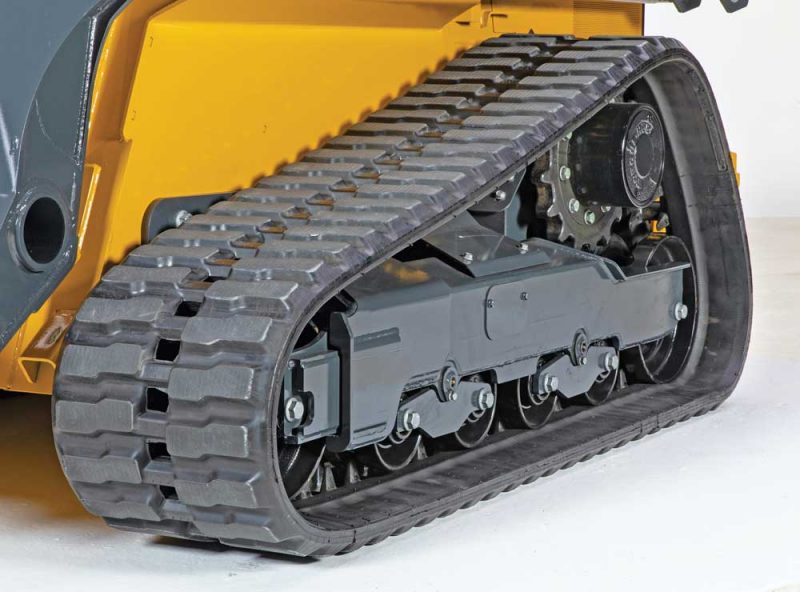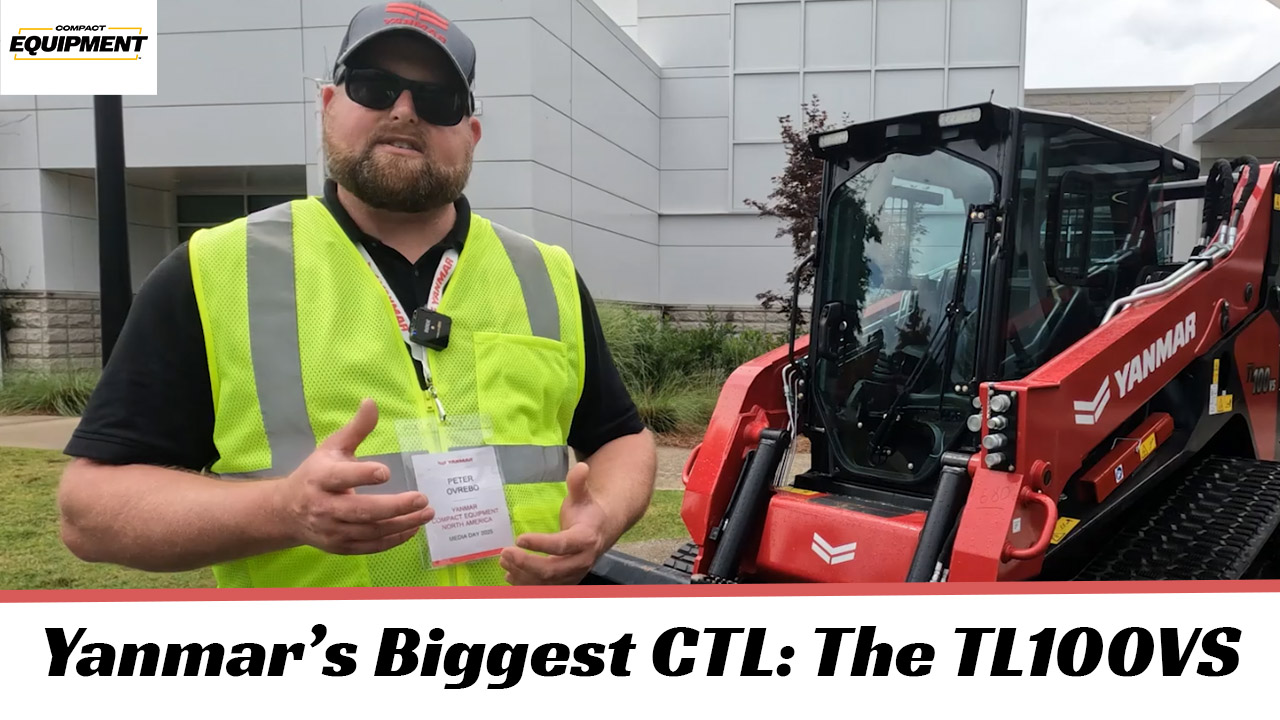Track Tips: Insights into Managing a Compact Track Loader’s Rubber Treads

Track maintenance is vital to the performance and uptime of your compact track loader. By training your operators, inspecting and cleaning tracks and maintaining proper tension, you can extend track life, limit downtime and reduce operating costs. It is important to handle your equipment with care. Track loaders excel in soft underfoot conditions like dirt and mud. If you work primarily on asphalt or concrete, a wheeled skid steer loader or compact wheel loader might be a better choice, as these conditions wear the rubber surfaces of a track at a faster rate. If you must run a track loader on hard surfaces, consider sprinkling sand or dirt in the machine’s path to reduce track wear.
It is also important to select the right tracks for the job at hand. Many manufacturers like John Deere offer multiple track tread pattern options that can used based on the intended application. One type of track option is a zig-zag style tread pattern. This pattern bites into the soil to provide more traction while pushing. It is most efficient for going over the rolling components of the undercarriages. A downside to this track pattern is its reduced capabilities while working perpendicular to a slope. Another option is a block lug track tread pattern, which features staggered block lugs in the design. This pattern tends to be more durable than the zig-zag track tread pattern. The block lug pattern is able to handle rougher applications with lots of debris and rocks. It also performs better on hillsides than other track tread patterns.
The biggest factor in track life is the operator and application, which have a much larger impact than the design, chemistry or origin of the track. Counter rotation of the machine on hard surfaces will wear the treads down quicker than working on softer dirt surface. Common damages can occur when working on surfaces with sharp and jagged rocks. Additionally, if you are working in areas with exposed steel rebar, the rebar can tear the tracks if you are not careful. Any surface can cause damage to your rubber track if not used properly and cautiously.
You can improve track life by being aware of the impact different surfaces can have on rubber tracks to prevent avoidable damages while also focusing on how you operate the machine. Instead of doing sharp powered rotation maneuvers at high speed, go slower. Also, do larger looping turns to prevent the tread pattern from wearing. It is important to train your operators to take wide turns instead of counter-rotating like on a skid steer to help minimize wear. Operators should avoid spinning the tracks and go up and down slopes rather than across to help reduce additional wear. It is best to teach all operators to keep the full length of the tracks on the ground as much as possible. When going over a curb, operators should approach it slowly and in a perpendicular direction to reduce pressure on the tracks and rollers from the rough and sharp surfaces of the curb.

Routine inspection and daily maintenance are key to avoiding premature track and component wear as well as unnecessary repairs. In addition, operators should check the tracks daily by examining for caked-on mud and debris. Do not allow mud to dry or freeze in the tracks, and use a shovel or pressure washer to remove the material immediately. It’s critical to remove and clean out any debris or mud daily from the undercarriage because it can harden and make the track stiffen up and potentially cause the rubber to slip off the rolling components. The debris can also become frozen, minimizing the capabilities of your machine. Therefore, it’s important to always have a clean undercarriage to prevent loss of productivity.
It is also important to pay extra attention to tension. Over- or under-tensioning the track is the main cause of track failure. If it is too tight, the track and other undercarriage components can wear excessively. A track that’s too tight causes component wear, robs the track loader of horsepower and burns more fuel. Also, this can create heat, which can permanently damage the rubber.
If the track is too loose, your machine may feel unstable and the track could come loose from the sprocket, exposing components to damage. It can also cause damage to the undercarriage, including the steel imbeds or the rubber itself. Therefore, one of the most important parts of daily maintenance on your track loader is checking and adjusting track sag. The track tension on your unit can be adjusted in a few minutes using a grease gun and a crescent wrench.
Here’s How to Achieve Proper Track Sag

Bring the track loader to a complete stop. Then lower the boom to raise the front end of the tracks approximately 8 in. off the ground. After removing any debris between the track and the sprocket, locate the third roller from the rear of the machine and measure the distance between the bottom of the roller and the top of the track. This distance is known as track sag. Check your operator’s manual for track sag specifications.
If the track tension is out of spec from the operator’s manual, remove the cover plate located on the frame of the undercarriage. This will give you clear visibility to the track adjuster valve and the grease fitting. If the track needs to be tightened, connect a grease gun to the grease fitting and add grease until the track idler extends far enough to bring the sag within recommended limits.
To loosen track tensions, slowly turn the track adjuster valve counterclockwise, which allows grease to escape through the bleed hole. Clean any excess grease from the zerk and dispose of it per environmental regulations. When the amount of track sag is satisfactory, turn the track adjuster valve clockwise to tighten. With the track sag within the recommended limits, reattach the cover plate and repeat the steps above the opposite side of the machine. After just a few short minutes, your track is adjusted to the optimal sag.
After inspecting the track tension, look for cuts or tears perpendicular to the tracks, missing chunks or uneven wear around the sprocket/roller area. These are all indications that the operator is not maintaining proper daily maintenance and inspections. If cuts run parallel with the track, it’s usually okay to continue operation for a while, but perpendicular cuts or tears often result in complete failure. Steel or fiber belts run the length of the track similar to a radial tire. If the cords are intact, the track will usually last, but if they are severed, failure is probably imminent.
You should follow the service guidelines recommended by the machine manufacturer to help minimize downtime and extend the life of the parts. For example, John Deere recommends checking track tension on its products every week or every 50 hours of operation to maximize tread life. It is important to make sure your track is on and secured correctly. As always, refer to your operator’s manual to learn more about proper track maintenance and machine inspections.
This story is presented by John Deere.




